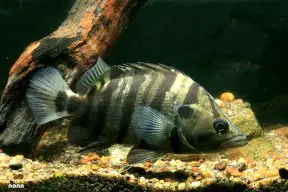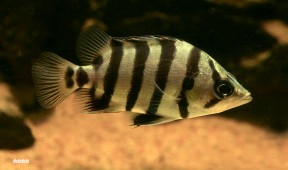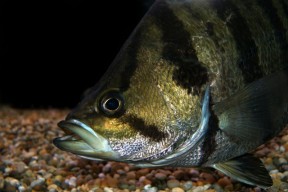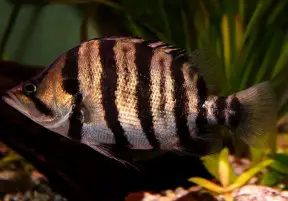Datnioides polota
Silver Tiger Perch
SynonymsTop ↑
Chaetodon quadrifasciatus Sevastianov, 1809; Datnioides quadrifasciatus (Sevastianov, 1809); Coius polota Hamilton, 1822; Coius binotatus Gray, 1834; Lobotes hexazona Bleeker, 1850
Etymology
Datnioides: from the genus name Datnia and Ancient Greek εἶδος (eîdos), meaning ‘form, likeness’.
polota: possibly derived from a Bengali vernacular name for the species.
Classification
Order: Perciformes Family: Datnioididae
Distribution
Currently understood to be widely distributed in Southeastern Asia, with confirmed records from India (Chilka Lake, Mahanadi and Hooghly rivers), Bangladesh (Ganges River delta), Myanmar (Yangon and Salween rivers), Thailand (Songkhla Lake, Tha Taphap and Chao Phraya rivers), Vietnam (Mekong River Delta), Malaysia (Perak, Bernam, and Melaka rivers, Peninsular Malaysia; Sarawak and Rajang rivers, Sarawak, Borneo), Singapore (Pulau Ubin), and Indonesia (Batang Hari River, Sumatra; Sambas, Kapuas and Barito rivers, Kalimantan, Borneo).
Records from Papua New Guinea refer to the congener D. campbelli.
Type locality is ‘estuaries of the Ganges River, India [now Bangladesh]’.
Habitat
Mostly inhabits brackish habitats such as estuaries, mangroves, coastal lagoons, irrigation canals, and the lower reaches of rivers, but has occasionally been recorded above the tidal limit.
Maximum Standard Length
250 – 300 mm.
Aquarium SizeTop ↑
An aquarium with base dimensions of 180 ∗ 60 cm should be the minimum considered.
Maintenance
Juveniles and subadults should be provided with a well-decorated aquarium with driftwood branches or mangrove roots. Larger individuals are relatively unfussy, although some surface cover in the form of floating or overhanging vegetation or branches is appreciated. Although it can survive in medium-to-hard freshwater this is naturally a brackish species, therefore the addition of marine salt to at least 10-20 % (the precise amount is unimportant) seawater strength is highly recommended.
Datnioides spp. typically produce a lot of waste so the use of large external filters is essential. If possible buy units with built in heaters or at least fit a sturdy heater-guard since adults have been known to damage submerged equipment. Sump systems also work well, and the heater can be housed within.
They do not travel well and can be tricky to stabilise post-import, often refusing to feed and continuously exhibiting a colour pattern indicative of stress but also displayed at night. In D. polota the body darkens considerably, and the vertical body bars become indistinct.
Water Conditions
Temperature: 20 – 28 °C
pH: 7.5 – 9.0
Hardness: 268 – 536 ppm
Diet
An efficient predator with highly protrusible mouthparts, feeding chiefly on smaller fishes and crustaceans. In the aquarium, juveniles can be offered chironomid larvae (bloodworm), small earthworms, chopped prawn, and suchlike, while adults will accept strips of fish flesh, whole prawns, mussels, live river shrimp, larger earthworms, etc. Older individuals do not require feeding on a daily basis, with 2-3 times per week sufficient.
This species should not be fed mammalian or avian meat such as beef heart or chicken since some of the lipids contained in these cannot be properly metabolised by the fish and may cause excess fat deposits and even organ degeneration. Similarly, there is no benefit in the use of ‘feeder’ fish such as livebearers or small goldfish, which carry with them the risk of parasite or disease introduction and tend not have a high nutritional value unless properly conditioned beforehand.
Behaviour and CompatibilityTop ↑
Can be maintained alongside similarly-sized fishes if sufficient space is available, but might be intimidated by territorial or otherwise competitive species.
Although juveniles may form groups, adults are not gregarious and tend to respond aggressively to conspecifics and similarly-shaped fishes. They are best maintained singly or in a group of 5 or more individuals.
Sexual Dimorphism
Unknown.
Reproduction
Unreported.
NotesTop ↑
In aquarium literature this species is also known as ‘silver tiger fish’, ‘American tiger fish (or ‘AT’)’, ‘silver datnoid’, and ‘silver dat’. The common name of ‘tiger fish’ is also used in reference to the African alestid genus Hydrocynus, therefore the more appropriate ‘tiger perch’ was suggested by Roberts and Kottelat (1994).
D. polota is sometimes referred to as D. quadrifasciatus (Sevastianov, 1809) but the original name of the latter, Chaetodon quadrifasciatus Sevastianov, 1809, is a junior primary homonym of the older Chaetodon quadrifasciatus Bloch & Schneider 1801, thus Coius polota Hamilton, 1822 takes precedence.
D. polota is distinguished from all congeners by the following combination of characters: colour pattern highly variable, up to 7 dark body bars, sometimes with 1-4 smaller bars between (vs. 6-7 wide bars in D. microlepis; 4-5 wide bars in D. pulcher; 4 thin bars sometimes with a single partial bar in D. undecimradiatus; 4-6 wide bars with diffuse margins in D. campbelli); predorsal profile distinctly concave (vs. almost straight in D. microlepis, D. pulcher and D. undecimradiatus); 20-23 rakers on the first gill arch (vs. 15-17 in D. campbelli); 9 branched anal-fin rays (vs. usually 10 in D. campbelli); body scales large, with 40-60 in the lateral series (vs. small, 70-100 in the lateral series in D. microlepis, D. pulcher and D. undecimradiatus).
Following Kottelat (2001), the genus Datnioides is diagnosed by the following combination of characters: second spinous anal-fin ray longer than the first and third rays; presence of fine teeth and 2-3 blunt spines on the edge of the opercle; 50+ lateral line scales; barred colour pattern.
Members were included in the genus Coius during the 1990s, but Coius is now considered to be a synonym of the genus Anabas (Kottelat, 2000). The former family name Coiidae is thus a synonym of Anabantidae, and Datnioides species comprise the monotypic family Datnioididae. The genus has also been included in the marine tripletail family Lobotidae in the past, and preliminary phylogenetic analyses suggest a close relationship these two groups.
References
- Hamilton, F., 1822 - Edinburgh & London: i-vii + 1-405
An account of the fishes found in the river Ganges and its branches. - Allen, G. R., A. W. Storey and M. Yarrao, 2008 - Ok Tedi Mininng: i-vii + 1-213
Freshwater fishes of the Fly River Papua New Guinea. - Kottelat, M., 2000 - Journal of South Asian Natural History 5(1): 91-94
The type species of the genus-group names Coius Hamilton, 1822 and Datnia Cuvier, 1829 and the type-genus of the family-group name Datnioididae Bleeker, 1858. - Kottelat, M., 2013 - Raffles Bulletin of Zoology Supplement 27: 1-663
The fishes of the inland waters of southeast Asia: a catalogue and core bibiography of the fishes known to occur in freshwaters, mangroves and estuaries. - Kottelat, M., 2001 - WHT Publications, Colombo: 1-198
Fishes of Laos. - Parenti, L. R. and K. K. P. Lim, 2005 - Raffles Bulletin of Zoology Supplement 13: 175-208
Fishes of the Rajang Basin, Sarawak, Malaysia. - Rainboth, W. J., 1996 - Rome, FAO: 1-265
FAO species identification field guide for fishery purposes. Fishes of the Cambodian Mekong. - Roberts, T. R., 1989 - Memoirs of the California Academy of Sciences No. 14: i-xii + 1-210
The freshwater fishes of western Borneo (Kalimantan Barat, Indonesia). - Roberts, T. R. and M. Kottelat, 1994 - Ichthyological Exploration of Freshwaters 5(3): 257-266
The Indo-Pacific tigerperches, with a new species from the Mekong basin (Pisces: Coiidae). - Tan, H. H. and M. Kottelat, 2009 - Ichthyological Exploration of Freshwaters 20(1): 13-69
The fishes of the Batang Hari drainage, Sumatra, with description of six new species.







